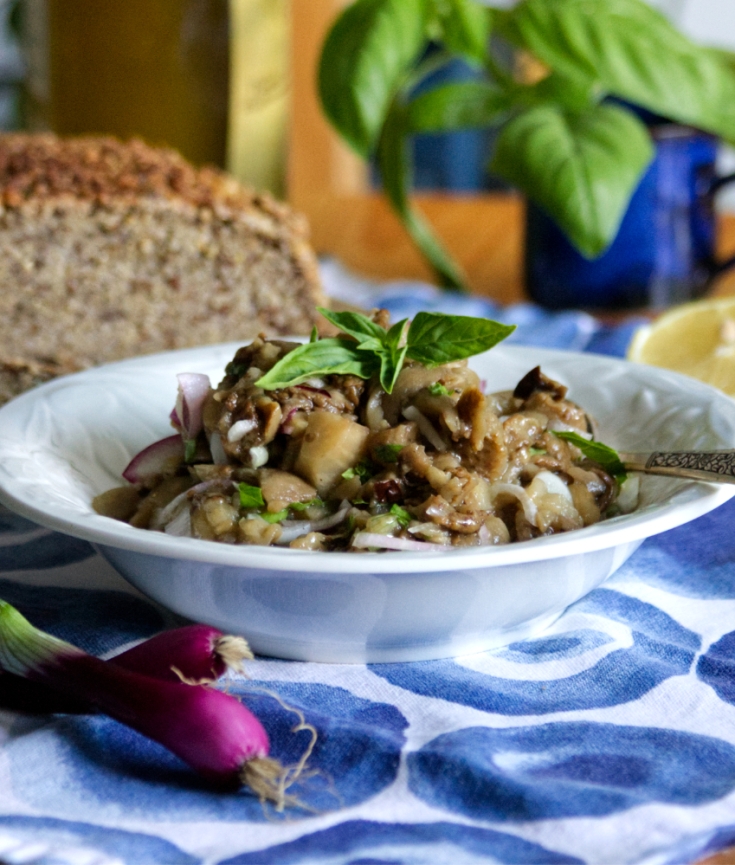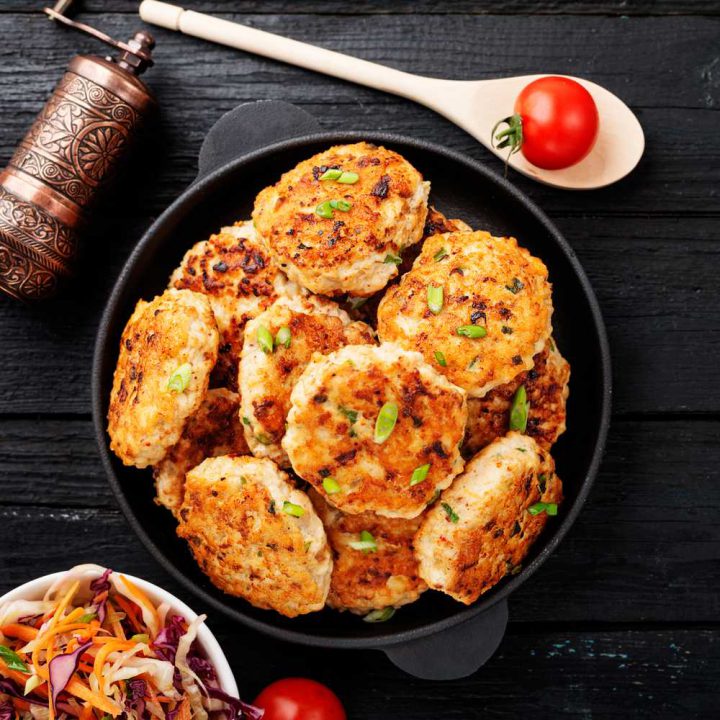
Hello, readers! Are you searching for a refreshing and nutritious salad recipe? Look no further, as we bring you the delectable Greek Aubergine Salad. This Mediterranean dish combines fresh vegetables, aromatic herbs, and tangy dressing to create a burst of flavors in every bite. Get ready to tantalize your taste buds with this amazing recipe.
Introduction
Greek Aubergine Salad, also known as Melitzanosalata in Greek, is a traditional dish that has gained popularity worldwide. This vibrant and colorful salad is a perfect blend of grilled eggplant, juicy tomatoes, crisp cucumbers, and tangy feta cheese. Drizzled with olive oil and sprinkled with fragrant herbs, it is a culinary delight that transports you to the sun-kissed beaches of Greece. Let's dive into the world of Greek cuisine and explore the wonders of this refreshing salad.
The Origins of Greek Aubergine Salad
The origins of Greek Aubergine Salad can be traced back to ancient Greece. Eggplants, a key ingredient in this salad, were first cultivated in the region around 600 B.C. The Greeks quickly recognized the versatility of this vegetable and incorporated it into various dishes, including salads. Over the centuries, the recipe evolved, and today, Greek Aubergine Salad is a cherished part of Greek culinary tradition.
The Health Benefits of Greek Aubergine Salad
Before we dive into the recipe, let's take a moment to appreciate the health benefits of this flavorful salad. Greek Aubergine Salad is not only a feast for the taste buds but also a nutritious addition to your diet. Here are some key benefits:
1. 🍆 Rich in Antioxidants: Eggplants are packed with antioxidants that help protect your cells from damage caused by free radicals.
2. 🥒 High in Fiber: Cucumbers and other vegetables in the salad are rich in fiber, promoting healthy digestion and aiding in weight management.
3. 🍅 Source of Vitamins: Tomatoes are a great source of vitamins A and C, which boost your immune system and promote healthy skin.
4. 🧀 Calcium-Rich: Feta cheese adds a creamy touch to the salad and provides a good dose of calcium for strong bones and teeth.
5. 🌿 Heart-Healthy: Olive oil, a staple ingredient in Greek cuisine, is known for its heart-protective properties and rich content of monounsaturated fats.
These are just a few examples of the health benefits you can enjoy by incorporating Greek Aubergine Salad into your diet.
Ingredients Required
| Ingredients | Quantity |
|---|---|
| Eggplants (grilled and diced) | 2 large |
| Tomatoes (diced) | 2 medium |
| Cucumbers (sliced) | 1 large |
| Red onion (thinly sliced) | 1 small |
| Feta cheese (crumbled) | ½ cup |
| Kalamata olives | ¼ cup |
| Extra virgin olive oil | 3 tablespoons |
| Fresh lemon juice | 2 tablespoons |
| Fresh parsley (chopped) | 2 tablespoons |
| Fresh mint (chopped) | 1 tablespoon |
| Salt | To taste |
| Black pepper | To taste |
Advantages and Disadvantages of Greek Aubergine Salad
1. Advantages
Greek Aubergine Salad offers several advantages that make it a great addition to your culinary repertoire. Let's delve into the benefits:
1. Burst of Flavors: The combination of grilled eggplants, juicy tomatoes, and tangy feta cheese creates an explosion of flavors in every bite.
2. Nutritious: Greek Aubergine Salad is packed with a variety of vegetables, providing essential vitamins, minerals, and fiber.
3. Versatility: You can enjoy this salad as a side dish, appetizer, or even as a main course by adding protein-rich ingredients like grilled chicken or chickpeas.
4. Easy to Prepare: With simple ingredients and straightforward instructions, this salad can be prepared in no time, making it ideal for busy individuals.
5. Great for Summer: The refreshing flavors and cooling ingredients make Greek Aubergine Salad a perfect choice for hot summer days.
6. Customization Options: You can personalize the salad by adding your favorite ingredients, such as roasted peppers or sliced avocado.
7. Vegetarian and Gluten-Free: This salad is suitable for vegetarians and those following a gluten-free diet, making it a versatile option for various dietary restrictions.
2. Disadvantages
While Greek Aubergine Salad offers numerous advantages, it's essential to consider potential drawbacks as well:
1. Allergies and Intolerances: Some individuals may have allergies or intolerances to specific ingredients in the salad, such as dairy (feta cheese) or nightshade vegetables (eggplants and tomatoes).
2. Preparation Time: Grilling the eggplants and preparing the salad dressing may require some time and effort, which might be a limitation for individuals seeking quick and easy recipes.
3. Availability of Ingredients: Depending on your location, you may encounter difficulty finding certain ingredients, particularly if you live in an area with limited access to Mediterranean produce.
4. Taste Preferences: While the flavors of Greek Aubergine Salad are loved by many, individual taste preferences may vary. Some individuals may not enjoy the combination of tangy feta cheese with the earthy flavor of grilled eggplants.
5. Food Waste: If not consumed promptly, the fresh vegetables in the salad may spoil, resulting in food waste.
6. Potential Stains: The deep purple skin of eggplants has the potential to stain clothing and kitchen surfaces, requiring extra care during preparation.
7. Caloric Content: While Greek Aubergine Salad is generally considered healthy, the addition of cheese and olive oil can increase the caloric content. Individuals on low-calorie diets should consume this salad in moderation.
Frequently Asked Questions (FAQ)
1. Is Greek Aubergine Salad suitable for vegans?
Yes, Greek Aubergine Salad can be made vegan-friendly by omitting the feta cheese or using a vegan cheese alternative.
2. Can I grill the eggplants in the oven instead of using a grill?
Yes, if you don't have access to a grill, you can roast the eggplants in the oven at 400°F (200°C) until they are tender and slightly charred.
3. Can I make Greek Aubergine Salad in advance?
Yes, you can prepare the salad components in advance and assemble them just before serving to retain the freshness and crunchiness of the vegetables.
4. How long does Greek Aubergine Salad last in the refrigerator?
When stored in an airtight container in the refrigerator, Greek Aubergine Salad can remain fresh for up to 3 days.
5. Can I substitute other vegetables in the salad?
Absolutely! Greek cuisine encourages experimentation and adaptation. Feel free to substitute or add vegetables according to your taste and availability.
6. Can I use dried herbs instead of fresh herbs?
Fresh herbs are recommended for the best flavor, but if you don't have access to fresh herbs, you can use dried herbs. However, reduce the quantity by half, as dried herbs are more potent.
7. Can I add protein to the salad?
Yes, Greek Aubergine Salad can be enhanced with the addition of protein-rich ingredients like grilled chicken, shrimp, or chickpeas to make it a complete and satisfying meal.
8. Can I make a larger batch of dressing and store it for future use?
Absolutely! You can make a larger quantity of the dressing and store it in the refrigerator for up to a week. Just give it a good shake before using.
9. Can I serve Greek Aubergine Salad with bread?
Yes, Greek Aubergine Salad pairs beautifully with crusty bread, such as pita or baguette, adding a delightful crunch and making it a more filling meal.
10. Is Greek Aubergine Salad suitable for a picnic or outdoor gathering?
Absolutely! Greek Aubergine Salad is a fantastic choice for picnics and outdoor gatherings, as it can be easily packed and remains fresh for several hours.
11. Can I use balsamic vinegar instead of lemon juice in the dressing?
While lemon juice adds a tangy freshness to the salad, you can substitute it with balsamic vinegar if you prefer a sweeter flavor profile.
12. Can I add Greek yogurt to the dressing?
Absolutely! Greek yogurt can be added to the dressing to create a creamier texture and a subtle tang. Just reduce the amount of lemon juice accordingly.
13. Can I garnish the salad with other herbs?
Yes, Greek Aubergine Salad can be garnished with additional herbs like dill or oregano to enhance the aroma and visual appeal.
Conclusion: Time to Savor the Greek Aubergine Salad
Now that you have discovered the wonders of Greek Aubergine Salad, it's time to try this delicious and healthy recipe yourself. Whether you're a seasoned cook or a novice in the kitchen, this salad is a delightful addition to your culinary repertoire. So, gather the ingredients, fire up the grill, and let the flavors of the Mediterranean transport you to a sunny Greek island. Enjoy the freshness, savor the flavors, and embark on a journey through the vibrant world of Greek cuisine.
Remember, Greek Aubergine Salad offers a myriad of health benefits and can be customized to suit your taste preferences. Don't hesitate to experiment with different vegetable combinations, dressings, or protein additions. Let your creativity shine and make this salad your own signature dish.
Thank you for joining us on this culinary adventure. We hope you enjoyed the journey. So, go ahead, embrace the vibrant colors and flavors of Greek Aubergine Salad, and start creating your own Mediterranean masterpiece. Bon appétit!
Closing Statement
In conclusion, the Greek Aubergine Salad is a delightful recipe that not only satisfies your taste buds but also provides numerous health benefits. The combination of grilled eggplants, fresh vegetables, and flavorful herbs creates a salad that is both nutritious and delicious.
However, it is important to consider individual preferences and any potential disadvantages, such as allergies or the availability of ingredients. Additionally, the preparation time and potential stains from eggplants should be taken into account.
Overall, the advantages of Greek Aubergine Salad outweigh the disadvantages, making it a great addition to your culinary repertoire. So, don't hesitate to try this Mediterranean delight, customize it to your liking, and enjoy the burst of flavors it offers.
Disclaimer: The information provided in this article is for educational purposes only and should not be considered as medical advice. Please consult with a healthcare professional or nutritionist before making any significant changes to your diet.







